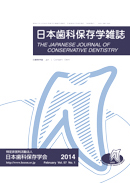Volume 57, Issue 2
Displaying 1-11 of 11 articles from this issue
- |<
- <
- 1
- >
- >|
Review
-
2014 Volume 57 Issue 2 Pages 111-120
Published: 2014
Released on J-STAGE: May 07, 2014
Download PDF (880K)
Original Articles
-
2014 Volume 57 Issue 2 Pages 121-129
Published: 2014
Released on J-STAGE: May 07, 2014
Download PDF (8067K) -
2014 Volume 57 Issue 2 Pages 130-136
Published: 2014
Released on J-STAGE: May 07, 2014
Download PDF (833K) -
2014 Volume 57 Issue 2 Pages 137-144
Published: 2014
Released on J-STAGE: May 07, 2014
Download PDF (2616K) -
2014 Volume 57 Issue 2 Pages 145-153
Published: 2014
Released on J-STAGE: May 07, 2014
Download PDF (1802K) -
2014 Volume 57 Issue 2 Pages 154-161
Published: 2014
Released on J-STAGE: May 07, 2014
Download PDF (6421K) -
2014 Volume 57 Issue 2 Pages 162-169
Published: 2014
Released on J-STAGE: May 07, 2014
Download PDF (1914K) -
2014 Volume 57 Issue 2 Pages 170-179
Published: 2014
Released on J-STAGE: May 07, 2014
Download PDF (15888K) -
2014 Volume 57 Issue 2 Pages 180-187
Published: 2014
Released on J-STAGE: May 07, 2014
Download PDF (1061K)
Case Report
-
2014 Volume 57 Issue 2 Pages 188-196
Published: 2014
Released on J-STAGE: May 07, 2014
Download PDF (2716K)
Erratum
-
2014 Volume 57 Issue 2 Pages 199
Published: 2014
Released on J-STAGE: May 07, 2014
Download PDF (56K)
- |<
- <
- 1
- >
- >|
